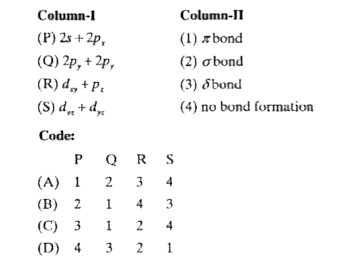Assume that the internuclear axis is z-axis . What type of bonds can be formed by Px orbitals ? Solution in Malayalam
π bond
σ bond
δ bond
no bond will be formed
Step by step video & image solution for Assume that the internuclear axis is z-axis . What type of bonds can be formed by P _(x) orbitals ? by Chemistry experts to help you in doubts & scoring excellent marks in Class 11 exams.
Topper's Solved these Questions
- BOOK - BRILLIANT PUBLICATIONCHAPTER - CHEMICAL BONDING AND MOLECULAR STRUCTUREEXERCISE - QUESTION (LEVEL -ll)42videos
CHEMICAL BONDING AND MOLECULAR STRUCTURE
- BOOK - BRILLIANT PUBLICATIONCHAPTER - CHEMICAL BONDINGEXERCISE - LEVEL-III ( Linked Comprehension Type )12videos
CHEMICAL BONDING
- BOOK - BRILLIANT PUBLICATIONCHAPTER - CHEMICAL THERMODYNAMICS EXERCISE - LEVEL-III52videos
CHEMICAL THERMODYNAMICS
Similar Questions
Which of the following species are hypervalent ?
(l) ClO−4
(ll) BF3
(lll) SO2−4
(lV) CO2−302:09View SolutionIn an ionic bond, the cation tends to polarize the electron cloud of the anion by pulling electron dens towards itself. This causes development of covalent character in the ionic bond because the electron dens gets localised in-between the nuclei. The tendency of the cation to bring about the polarization of the anion expressed as its polarizing power. The ability of ion to undergo polarization is called its polarisability. The polarising power of a cation or an anion is decided on the basis of Fajans' rules.
The ionic conductance of which of the following is the highest?View Solution1.0 mole of a monoatomic ideal gas is expanded from state (1) to state (2) as shown in the figure. Calculate ti work done for the expansion of gas from state (1) to state (2) at 298 K
 02:32View Solution
02:32View SolutionWhich of the following combination of orbitals can not form bond. (If x axis in internuclear axis)
02:57View SolutionWhich of the following orbitals can form pi bond , if internuclear axis is y-axis ?
03:16View SolutionTaking z-axis as internuclear axis, eplain why 2p_(x) or 2p_(y) -orbital does not combine with 2s-orbital to form molecular orbitals.
View SolutionWhich of the following overlaps of atomic orbitals does not form π-bond if z-axis is the internuclear axis?
02:43View SolutionIf z-axis be the internuclear axis, which of the following combination of orbitals would not form pi -bond?
View SolutionWhich of the following combination of orbitals do / does not form bond (if x-axis is internuclear axis) ?
01:36View SolutionWhich of the following combinations of atomic orbitals gives antibonding pi MO (assume z - axis as internuclear axis) ?
02:10View SolutionMatch the overlapping of orbitals with the type of bond formed. (Consider x-axis as internuclear axis.)
 01:43View Solution
01:43View SolutionLabel the molecular orbitals formed by the following combinations of atomic orbitals if Z-axis is the internuclear axis.
1s−1s02:04View SolutionLabel the molecular orbitals formed by the following combinations of atomic orbitals if Z-axis is the internuclear axis.
2px−2px03:27View SolutionLabel the molecular orbitals formed by the following combinations of atomic orbitals if Z-axis is the internuclear axis. 2p_z - 2P_z
02:29View SolutionLabel the molecular orbitals formed by the following combinations of atomic orbitals if Z-axis is the internuclear axis.
2py−2Py03:43View Solution

